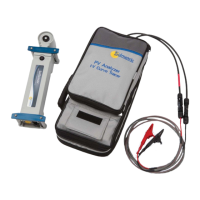7 Interpreting Measured I-V Curves
7-8
Array Is Partially Shaded, or non-uniform soiling or debris is present
Partial shading of a PV cell reduces the current capacity of that cell, which in turn
reduces the maximum current that can be produced by other series connected cells. For
example, slightly shading one cell in a 72 cell module that has 3 bypass diodes will
slightly reduce the current in 24 cells. Bypass diodes prevent that cell from going into
reverse bias. If the PV module is supplying a load and the current demanded by the load
is above the (reduced) current provided by the partially shaded cells, the bypass diode
will begin conducting and pass current around the shaded cell strings. Without the bypass
diode present, the cells would be reverse biased, which can generate potentially damaging
reverse breakdown voltage and hotspot failure. The impact of partial shading on the I-V
curve is to create a notch. In a single PV string, the vertical height or current at which the
notch appears is equal to the reduced short-circuit current of the partially shaded cells.
The horizontal or voltage distance from V
oc
to the notch is related to the number of cell
strings within modules that have been bypassed.
PV Cells Are Damaged
In a cracked cell, a portion of the cell may be electrically isolated. This has the same
effect on the I-V curve as shading of an equivalent area of a normal cell. A notched I-V
curve can result depending on the severity of the PV cell damage.
Cell String Conductor Is Short Circuited
A localized hot spot, as discussed in X. Steeper Slope in Horizontal Leg, can also cause a
bypass diode to turn on, effectively removing a cell string from production.
2. Low Current
Potential causes for the measured I
sc
being higher or lower than predicted are summarized
below, and then discussed in more detail.
Potential causes located in the array include:
• Uniform soiling
• Strip shade
• Dirt dam
• Module degradation

